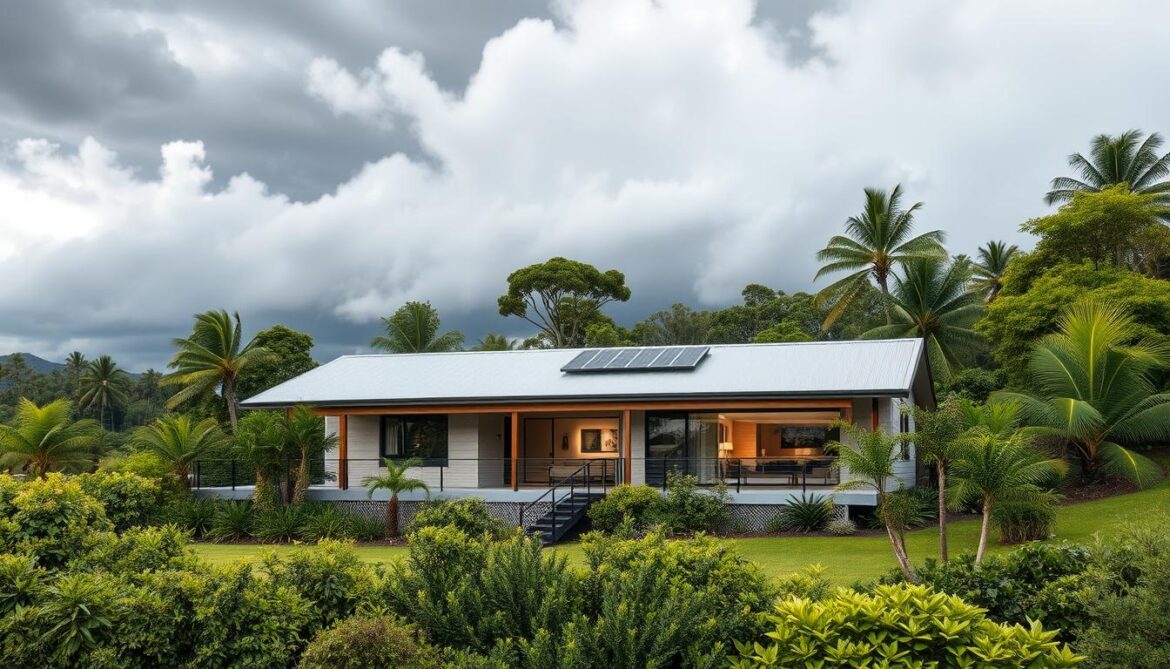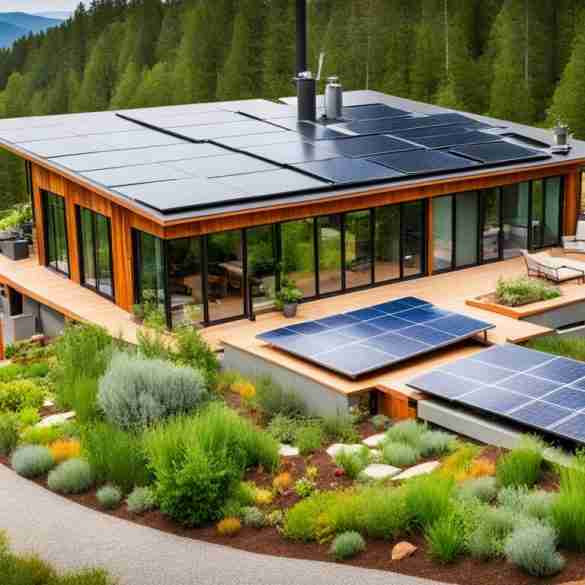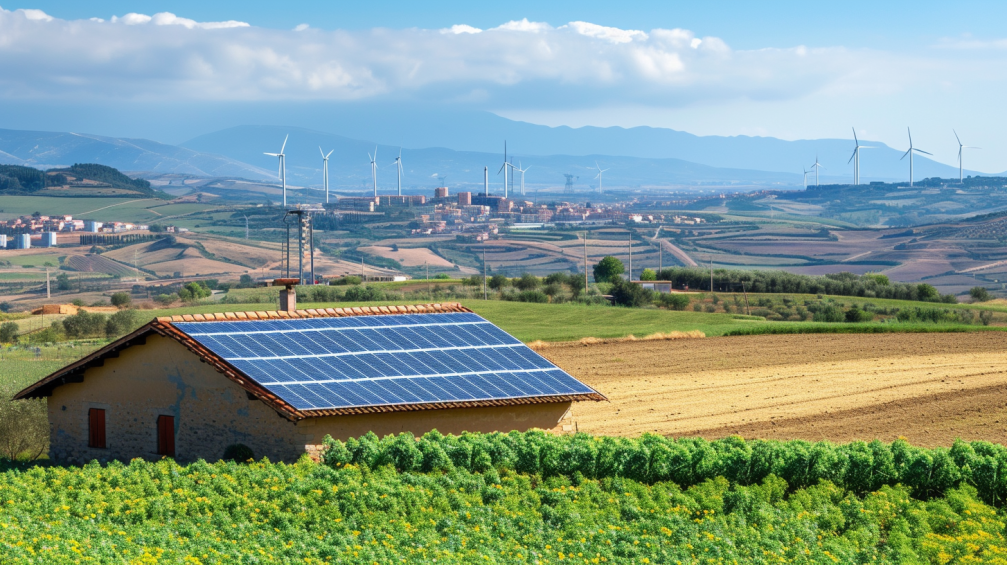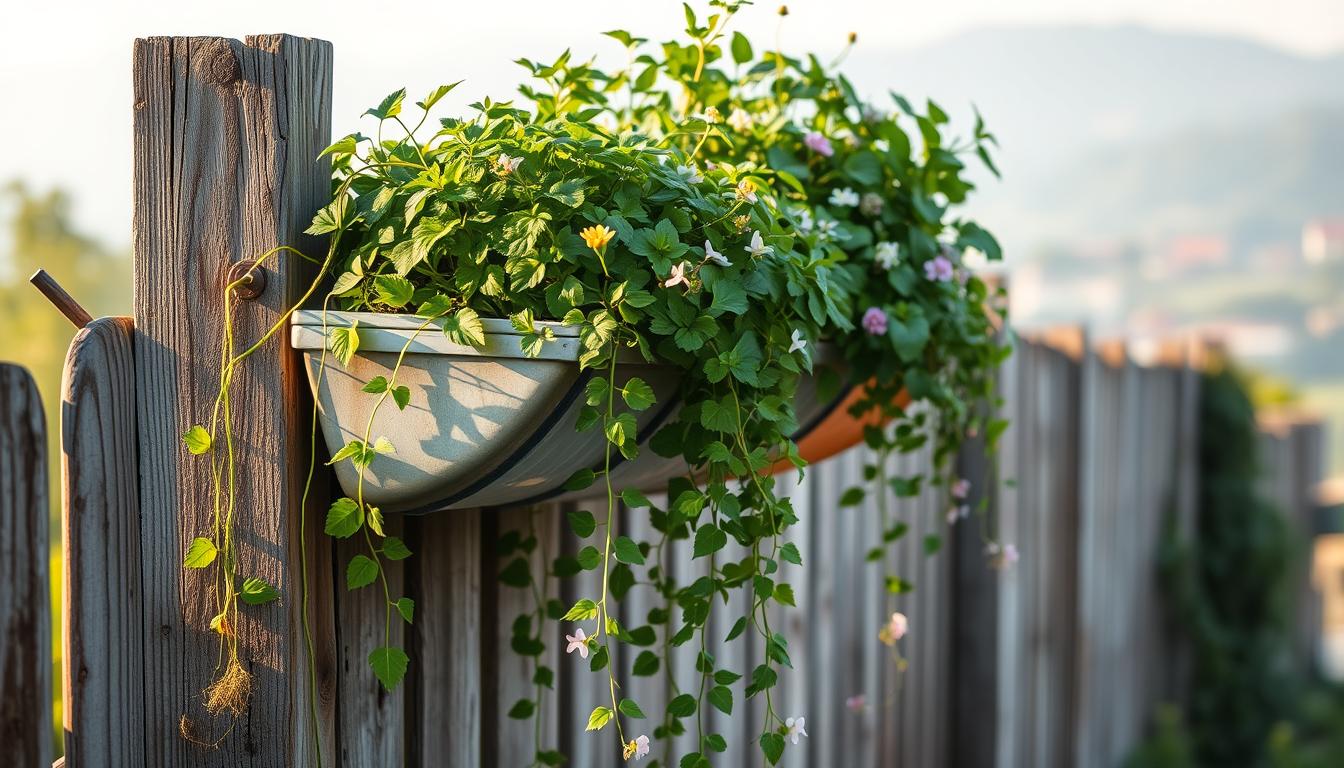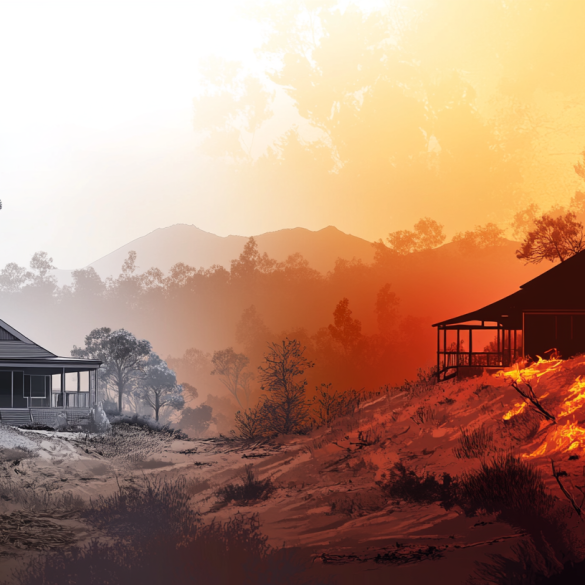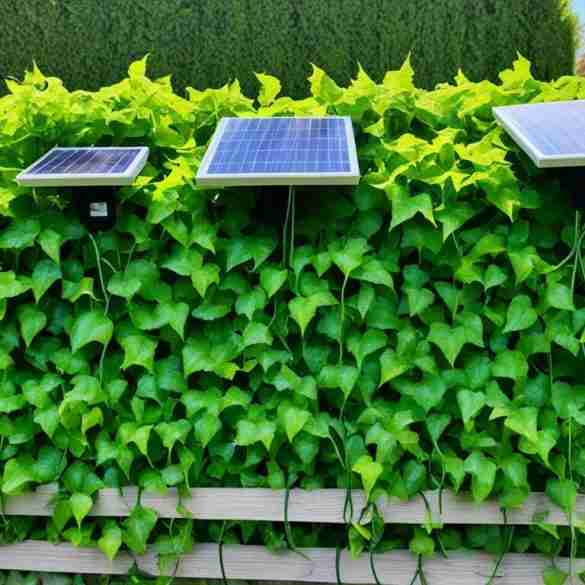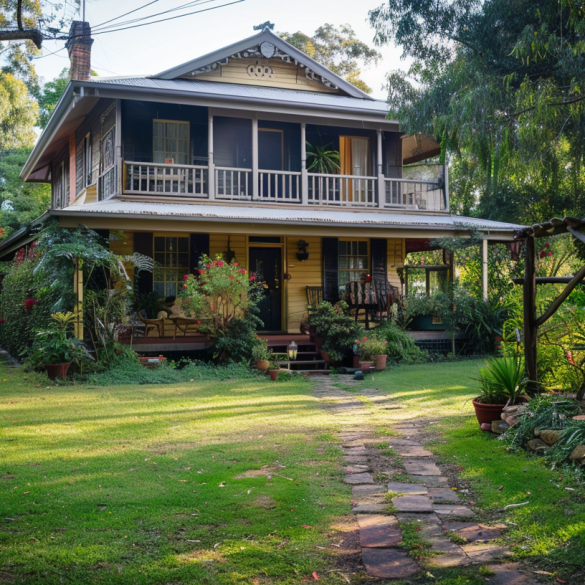Can you keep your eco-friendly home safe from Queensland’s big storms? The answer is yes. Sustainable living in Queensland means your home can be safe too.
Queensland’s weather is tough, with winds up to 310 kilometres per hour. Cyclone Yasi in 2011 showed that new homes can stand strong. Only 3% of new roofs got damaged, while 20% of older roofs did.
This guide will show you how to make your home safe and green. You’ll learn ways to keep your family and home safe.
Building homes that are green can also make them stronger against storms. We’ll talk about how to secure solar panels and use rainwater tanks to fight floods. These ideas are easy on your wallet and keep your home safe.
Key Takeaways
- Queensland homes must withstand winds up to 310km/h under current building codes
- Modern cyclone-resistant construction shows 85% better roof retention than older designs
- Sustainable building materials can enhance both environmental performance and storm resilience
- Solar systems and rainwater tanks require specific cyclone-rated installation methods
- Retrofitting existing homes combines cost-effective upgrades with improved weather protection
- Climate-adaptive design principles reduce both environmental impact and storm damage risk
Why is preparing for a cyclone so important in coastal Queensland?
Living by the Queensland coast has its challenges. Your home faces powerful forces that can be unpredictable and harmful. Disaster preparedness is more than just building codes. It’s about keeping your family, home, and lifestyle safe.
Cyclone Yasi in 2011 showed the difference between ready and unready homes. Older homes were badly damaged, while newer cyclone resilient homes were barely touched. This shows that being prepared can save your home and your life.
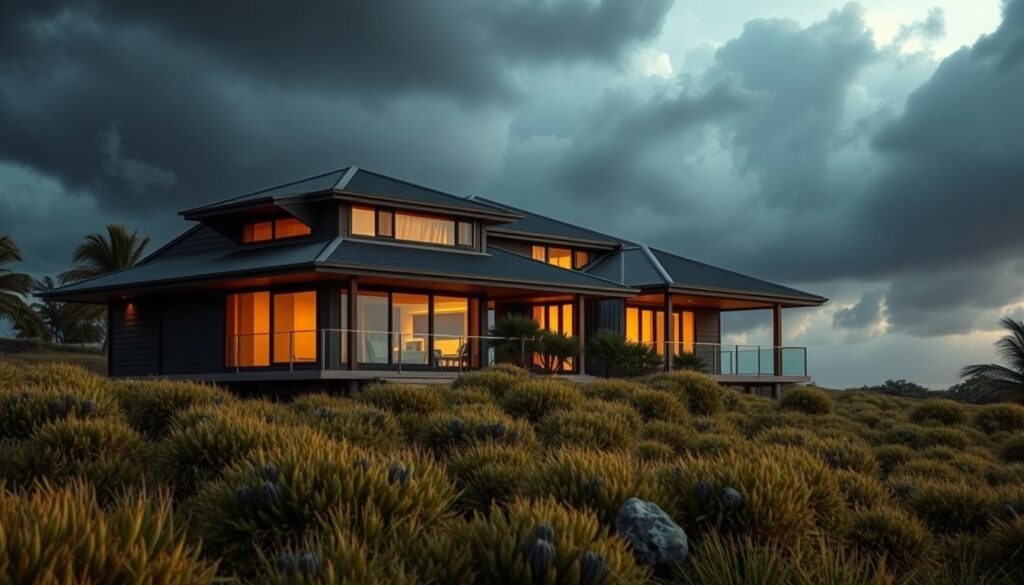
What kind of damage can a cyclone actually do to a house?
Cyclones bring strong winds and other dangers. The biggest threat is uplift pressure, which tries to lift your roof off. At 200 km/h, this pressure is like several tonnes trying to lift your roof.
Water damage can be even worse than wind damage. Rain can get in through small gaps, flooding your home and ruining everything inside. Natural disaster preparedness means knowing cyclones can damage both your home’s structure and its contents.
Flying debris is a big danger in severe weather. Even a simple door can break through walls. Roof tiles, tree branches, and vehicles can turn into deadly missiles.
How often do strong cyclones hit the Queensland coast?
Queensland gets 4-6 tropical cyclones a season, from November to April. But not all cyclones are the same. Category 3, 4, and 5 cyclones, which can seriously damage buildings, happen every 3-5 years.
The risk varies by location and decade. Some places might not see a major storm for 10-15 years, while others face them more often. This makes disaster preparedness a must for coastal residents.
La Niña and El Niño affect cyclone activity in the region. La Niña years often see more cyclones and severe weather. Knowing these patterns helps you prepare for busier seasons.
Are some parts of coastal Queensland more at risk than others?
The far north Queensland coast, including Cairns and Cape York, is the most at risk. This area is hit by severe weather more often. Towns like Cooktown and Port Douglas have been rebuilt many times after cyclones.
Central Queensland, including Mackay and the Whitsundays, also faces a high risk. This area has seen some of Australia’s worst cyclones, like Cyclone Debbie in 2017. Its coastal location and geography make it very vulnerable.
The Gold Coast and Sunshine Coast are less often hit by severe cyclones but need preparation. They face risks like severe storms and flooding, which can damage unprepared homes.
Your risk level depends on many factors, not just where you live. How close you are to the coast, your elevation, the terrain around you, and local wind patterns all play a part. Cyclone resilient homes consider these factors during design and construction.
Knowing your local risk helps you choose the right protection strategies. Areas at higher risk might need more investment in structural upgrades. Lower-risk areas might focus on basic preparedness and emergency planning.
What makes a house strong enough to stand up to cyclone winds?
Creating cyclone-resistant design is more than just using strong materials. It’s about how your roof, walls, windows, and doors work together. They must form a strong shell that can handle winds over 310km/h.
The strength of your home comes from understanding wind forces. When cyclone winds hit, they don’t just push on one side. They create pressure differences that can lift roofs, break windows, and make garage doors weak points.
Modern storm-resistant construction uses special connections and designs. Let’s look at the key elements that make a house cyclone-proof.

Understanding cyclone ratings and what they mean for your home
Cyclone ratings show how much wind your home can take before damage. In Australia, homes near the coast need ratings from N3 to N6.
An N3 rating means your home can handle winds of 185km/h. N4 can take 210km/h, and N5 can handle 250km/h. The highest, N6, protects against winds over 310km/h, seen in Category 5 cyclones.
Your cyclone rating depends on three things:
- Location – how close to the coast and local topography
- Building height – taller homes face stronger winds
- Terrain category – open coast versus sheltered inland
Knowing your rating helps choose the right materials and construction. It’s not just about meeting standards – it’s about keeping your family safe.
How your roof connects to the rest of your house
The roof-to-wall connection is key in cyclone-resistant design. Traditional homes use nails, but cyclone-proof homes need special fasteners to stop roof lift-off.
Cyclone clips and tie-down straps make a continuous path from roof to foundation. They safely transfer wind forces through your structure, avoiding weak points.
Proper roof battening is vital. Standard homes use 90mm nails, but resilient construction needs 100mm screws. These screws hold better and resist cyclical loading.
The spacing of roof battens also matters. While standard homes use 900mm centres, cyclone-rated homes need 600mm or closer. This even distribution prevents battens from failing under extreme pressure.
Why cyclone-proof windows and garage doors are absolutely critical
Your windows and garage doors are key to your home’s survival in a cyclone. These openings are the biggest vulnerabilities, and failure can cause major damage.
Impact-resistant windows use laminated glass that stays together even when cracked. Unlike regular glass, laminated glass holds its shape, keeping your home safe.
Garage doors face unique challenges because of their size and light weight. A failed garage door lets wind in, causing internal pressure that can damage walls and roofs. Storm-resistant construction uses:
- Reinforced door panels – thicker materials with internal bracing
- Heavy-duty tracks and hardware – designed for lateral wind loads
- Additional support posts – temporary bracing during storms
- Barrel bolt systems – multiple locking points along the door
Window and door frames need special attention. Standard aluminium frames may not support the structure. Cyclone-rated frames use thicker materials and stronger corners to resist wind.
How house shape affects cyclone safety
The shape of your home affects how wind flows around it. Aerodynamic design can reduce wind loads by up to 40%, making your home safer and potentially saving money.
Hip roofs perform better than gabled roofs in cyclones. Homes with hip roofs, angled on all sides, suffer less damage than those with traditional gabled ends. The streamlined shape allows wind to flow smoothly.
Building shape also affects wind pressure distribution:
- Rectangular homes – simple shapes with minimal projections perform best
- L-shaped designs – create wind pressure concentration at corners
- Complex rooflines – multiple angles and levels increase structural stress
Roof pitch is important too. Resilient construction uses roof angles between 15 and 35 degrees. Flatter roofs reduce uplift forces, while steeper pitches can create suction effects.
Eaves and overhangs need careful thought. While they offer shade and weather protection, large overhangs can act like sails in high winds. The key is finding the right balance between functionality and structural integrity.
Your building’s orientation relative to prevailing winds also matters. Homes with their narrow end facing the most common storm directions typically experience lower wind loads and reduced structural stress during cyclones.
Can I build a strong cyclone-safe home without it being too expensive?
Building a cyclone-safe home doesn’t have to be pricey. Many Queensland homeowners think storm-proof construction means a big budget. But, with smart planning and the right materials, you can build a strong home without spending too much.
It’s possible to get great cyclone protection without high costs. The trick is knowing which investments are worth it. Also, using funding programs can help a lot.
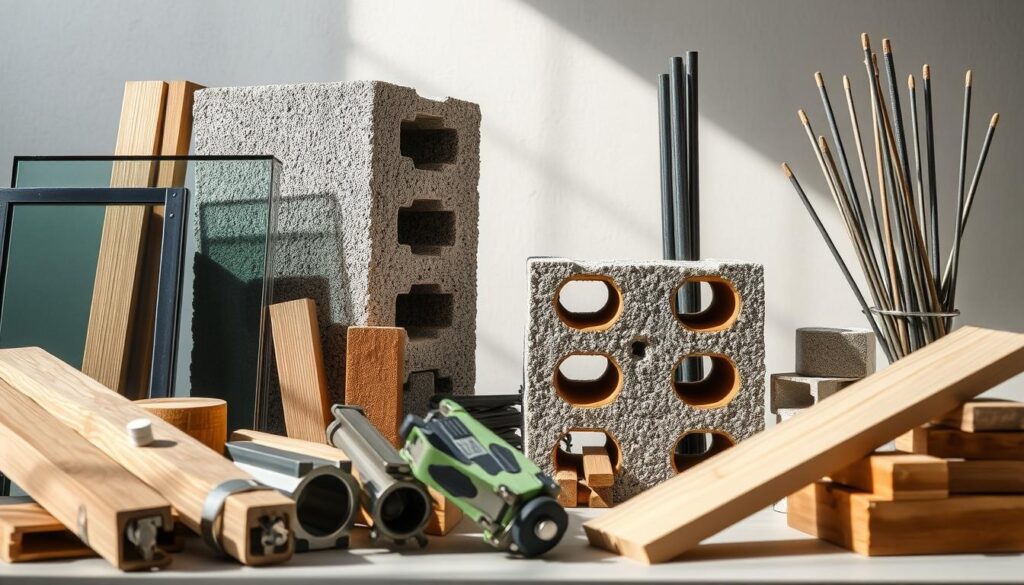
Are there affordable building materials that are also strong?
Yes! You don’t have to spend a lot on resilient building materials. Steel framing, for example, is only 10-15% more than timber. But it offers much better cyclone protection.
Concrete masonry blocks are strong and not too pricey. They’re made in Queensland, which saves on transport costs.
Engineered timber products like LVL are stronger than regular timber. They might cost more upfront but save on maintenance later.
The best way to save money is to focus on key parts like roof connections and wall framing. Don’t upgrade everything at once.
Using recycled steel roofing can be significantly cheaper than new materials. It meets all cyclone standards. Many suppliers offer recycled options that look just like new.
Does it cost more to build to cyclone codes than a standard house?
Building to Queensland building codes for cyclone areas adds 8-12% to costs. This covers stronger foundations, better roof connections, and impact-resistant windows.
But, this upfront cost saves money on insurance. Insurers give 15-25% discounts for cyclone-standard homes.
The cost difference gets smaller when you think about less maintenance. Storm-proof construction materials last longer and need fewer repairs.
| Building Component | Standard Cost | Cyclone-Rated Cost | Percentage Increase |
|---|---|---|---|
| Roof Framing | $8,000 | $9,200 | 15% |
| Wall Framing | $12,000 | $13,500 | 12.5% |
| Windows & Doors | $15,000 | $18,000 | 20% |
| Foundation | $25,000 | $27,500 | 10% |
Are there government grants or programs to help make my home safer?
Yes! The Resilient Homes Fund offers up to $741 million for Queensland homeowners. It’s a big help for making homes cyclone-proof.
Homeowners can get grants for up to 80% of the cost. The program helps homes in high-risk areas and those hit by disasters.
Local councils also give rebates for resilient building materials and energy upgrades. These programs vary, so check with your council for details.
The Queensland Reconstruction Authority has more funding for homes in disaster areas. This support is for both new homes and upgrading existing ones.
How can a good design save me money in the long run?
Good design choices save a lot of money over time. They cut energy bills, maintenance costs, and insurance premiums. A cyclone-safe home can save thousands each year.
Proper design for natural ventilation cuts cooling costs by 30-40%. This means lower electricity bills all year, not just during cyclones.
Designing for natural ventilation means no need for expensive mechanical systems. Cross-ventilation and thermal stack effects keep homes cool without air conditioning.
Quality storm-proof construction means less maintenance. You’ll spend less on repairs, repainting, and replacing parts over time.
Insurance companies give big discounts for well-designed cyclone-resistant homes. These savings add up over decades of owning the home.
Energy-efficient design, like proper insulation and solar orientation, can get extra government rebates. These incentives help lower your construction costs even more.
What eco-friendly materials are best for a coastal home?
The right eco-friendly building materials can make your coastal Queensland home strong against cyclones. You don’t have to choose between protecting the planet and your family. Today’s materials are strong and eco-friendly.
Coastal homes face special challenges. Salt air can damage metal in months. UV radiation can break down plastics and paints. Cyclonic winds test every part of your home. You need materials that are tough and green.
Modern sustainable architecture goes beyond recycled products. Engineers now make materials that beat traditional ones in coastal areas. These new materials show that being green doesn’t mean you have to sacrifice strength or safety.
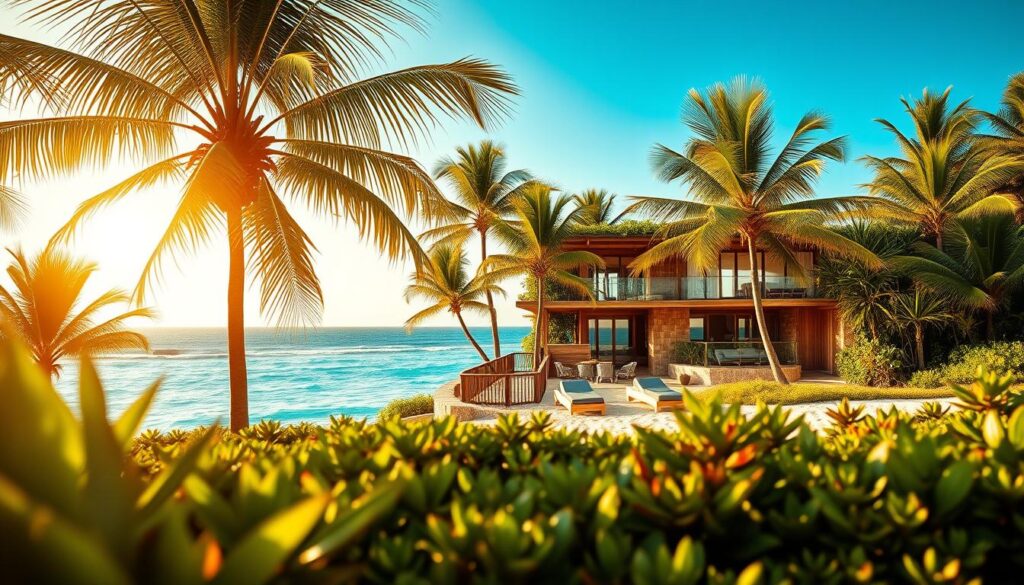
Can materials like recycled steel or bamboo really be strong enough?
Recycled steel is actually stronger than new steel in many ways. Recycling removes impurities that cause corrosion. Marine-grade recycled steel has more chromium and nickel, making it better against salt air.
Eco Block ICF is top for cyclone safety. It uses steel-reinforced concrete that’s good for the planet and very strong. It’s rated Category 5 and can withstand winds up to 250 km/h. The blocks use recycled materials and keep your home warm.
Bamboo is good for inside and non-structural parts. But it’s not strong enough for main parts in cyclone areas. Use bamboo for floors, cabinets, and decor where it’s best.
Engineered timber from sustainable wood is strong. Look for products certified by the Australian Forest Certification Scheme. These materials are tested to meet cyclone standards and support green forestry.
What kind of insulation works best in a tropical climate and is also sustainable?
Bulk insulation in tropical areas must handle humidity well. Sheep’s wool insulation controls moisture and fights mould. It keeps its insulating power even when damp, perfect for coastal areas.
Recycled polyester insulation works well in humid places. Made from recycled plastic bottles, it doesn’t absorb moisture and won’t grow mould. It keeps its R-value steady, even in Queensland’s wet season.
Tropical architecture focuses on reflective insulation. Radiant barriers made from recycled aluminium reflect heat away. They’re great in roof spaces where it gets very hot in summer.
Consider natural cork insulation for walls and floors. Cork resists moisture, insects, and fire. It’s harvested without harming trees, making it very sustainable. Cork also reduces noise from coastal winds.
How do I make sure my eco-friendly paint and finishes can handle the coastal weather?
Low-VOC and zero-VOC paints have gotten much better. But not all eco-friendly paints can handle coastal weather. Look for products made for marine environments and have environmental certifications.
Clay-based paints are breathable and fight mould. They let moisture pass through walls, preventing damage from trapped humidity. They’re great in places like bathrooms and kitchens.
Natural oil finishes protect timber surfaces from salt air. Tung oil and linseed oil deeply penetrate wood, lasting long. These finishes need more care than synthetic ones but are better for the environment.
Mineral-based exterior paints are durable in coastal areas. Made from natural earth pigments and mineral binders, they resist fading and peeling. These finishes can last 15-20 years with little upkeep.
Always test any eco-friendly finish in a small, hidden area first. Coastal conditions can vary a lot, even in Queensland. What works in one place might not work in another. Keep records to maintain your finishes and protect your home.
How can I make my current home safer from cyclones?
Making your home cyclone-safe is easier than you think. You can make big changes without tearing it down. Smart changes can turn your home into a safe place from cyclones, without breaking the bank.
First, know what makes your home vulnerable. The Resilient Homes Fund helps make your home safer from floods. This makes fixing your home more affordable than ever.
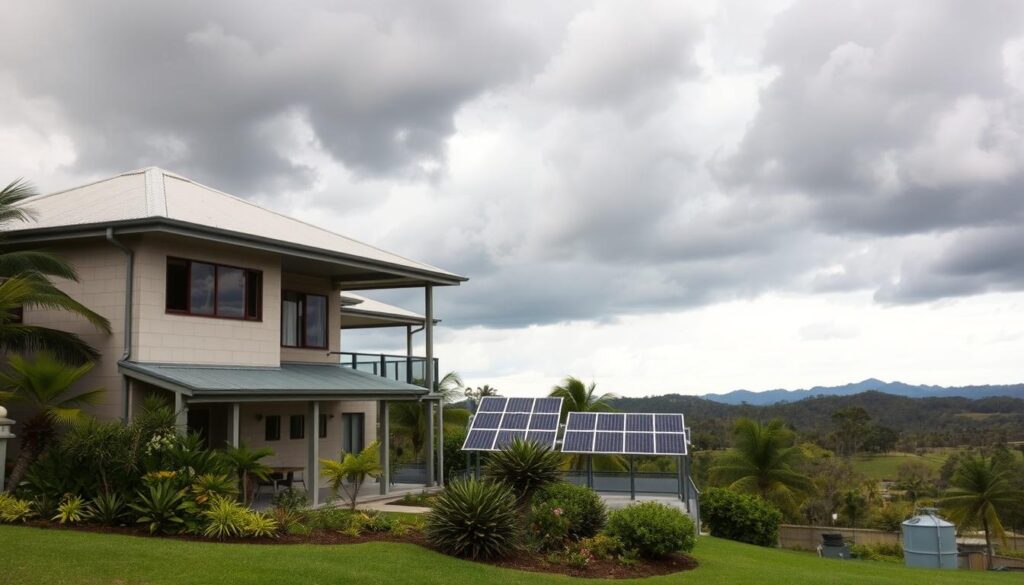
What is the first thing I should check or fix on my older home?
Start with the roof-to-wall connections. This is where most older homes fail in cyclones. Look for loose straps, corroded bolts, or gaps.
Then, check your roof sheeting. Look for loose screws, rust, or panels that move. Replace screws longer than 65mm with cyclone-rated ones.
Next, check windows and doors for gaps or damage. Small gaps can make your home a wind tunnel in a cyclone.
Can I add cyclone protection to my windows and doors without replacing them?
Yes, you can make your home safer without replacing windows and doors. Install cyclone shutters or screens that meet Australian Standards.
For sliding doors, add impact-resistant film or laminated glass. This costs $200-400 per door, much less than replacing them.
Strengthen door frames with metal plates around hinges and locks. This upgrade costs under $100 per door but boosts wind resistance a lot. Use heavy-duty hinges for cyclone conditions.
How can I strengthen my roof without having to build a new one?
Focus on connections, covering, and structure. Add cyclone ties between roof trusses and walls. These metal straps cost $15-25 each but prevent roof loss.
Upgrade roof fasteners to cyclone-rated screws. Use them every 150mm for cyclone areas. This costs $3,000-5,000 for an average home.
Consider adding a secondary water barrier under your roof. This membrane stops water if your outer roof is damaged. It protects your home’s interior and saves on repairs after a storm.
| Retrofit Option | Cost Range | Wind Resistance Improvement | Installation Time |
|---|---|---|---|
| Cyclone ties installation | $1,500-3,000 | Up to 40% stronger | 2-3 days |
| Roof fastener upgrade | $3,000-5,000 | 25-35% improvement | 3-5 days |
| Window protection systems | $200-800 per opening | 60-80% impact reduction | 1 day per home |
| Door reinforcement | $100-300 per door | 50% stronger frames | Half day per door |
Is it worth the money to retrofit an older house?
Retrofitting is a smart choice. It saves on insurance, increases property value, and gives you peace of mind. Climate-adapted housing can cut insurance costs by 10-30% each year.
A good retrofit can raise your home’s value by $20,000-50,000. Essential upgrades cost $10,000-25,000. The Resilient Homes Fund can cover up to $50,000 of eligible costs.
Think about the costs of not retrofitting. Major cyclone damage can cost $75,000-150,000 in repairs. Insurance covers some costs, but you’ll face deductibles and months of disruption.
Focus on key areas like roof connections, window protection, and door reinforcement. These improvements offer the biggest safety gains for your money. They create a solid base for resilient housing design that protects your family and finances.
Does the design of my yard and garden affect cyclone safety?
Every tree, shed, and garden feature around your home can be a danger or a defence when cyclones hit. Your landscape design is key to protecting your property or causing damage. Smart planning turns your outdoor space into a natural defence system for cyclone regions.
Choosing the right placement, materials, and plants is critical. Knowing how cyclone winds affect your landscape helps create a safe and sustainable yard.
What are the best types of trees to plant near a coastal home?
Native Queensland trees are great for coastal homes. Coastal banksia, bottlebrush, and native frangipani resist strong winds and salt spray. They have deep roots and flexible branches that bend in storms.
Plant big trees 10 metres from your house to avoid damage if they fall. Smaller native shrubs like coastal rosemary and saltbush can be closer for windbreaks. These plants also support local wildlife and need little water.
Avoid eucalyptus trees near your home as they drop big branches. Palm trees can be dangerous when their fronds break off in high winds. Choose trees with strong, flexible wood and compact growth.
How should I manage water runoff to prevent flooding and erosion?
Good drainage protects your home’s foundation and stops erosion. Install swales and rain gardens to direct water away from buildings. These features manage stormwater naturally, supporting cyclone region living.
Make sure water flows away from your house at a slope of 1-2% minimum. Use permeable paving like gravel or concrete for driveways and paths. This lets water soak into the ground instead of rushing to your home.
Plant native grasses and groundcovers on slopes to stop erosion. Species like lomandra and native violets hold soil in place during heavy rains. Consider a bioswale along your boundary to manage neighbourhood runoff.
Why is it a bad idea to have gravel or loose paving stones in the yard?
Loose materials become dangerous missiles in cyclone winds, capable of breaking windows and causing serious injuries. Decorative gravel, loose pavers, and garden ornaments can travel at deadly speeds. Even small stones can damage your home’s exterior.
Replace loose gravel with fixed paving or plant groundcover instead. If you like stone, choose large, heavy rocks or concrete pavers with a proper base. Secure all outdoor furniture and decorations before cyclone season.
Garden mulch should be chunky and heavy, not lightweight chips that can blow away. Crushed shell or coarse bark mulch stays in place better. Consider living mulch options like native groundcovers for windy areas.
Where is the safest place to put a shed or water tank?
Strategic placement of outbuildings and water storage protects them and your main house from cyclone damage. Position sheds and water tanks on the lee side of your property (away from prevailing winds) and anchor them securely to concrete foundations. This approach aligns with queensland home design principles that consider the entire property as a safety system.
Water tanks should be at least 6 metres from your house to prevent damage if they’re dislodged. Choose low-profile tank designs that present less surface area to wind. Partially burying large tanks or building retaining walls around them provides extra protection.
Sheds work best when positioned to shield your home from wind and flying debris. Ensure they’re properly engineered for cyclone loads and consider them cyclone shelters if built to standards. Always secure shed doors and windows, as open openings can cause the structure to lift off its foundation.
Create clear zones around your house by removing or securing anything that could become airborne. This includes outdoor furniture, potted plants, and garden tools. A well-planned landscape becomes part of your home’s cyclone defence system, protecting your investment while supporting the environment.
Remember that insurance companies often consider landscape-related damage when assessing claims. Proper planning not only keeps your family safe but can also help with insurance coverage and property values in cyclone-prone areas.
Are there official rules and codes I have to follow?
Building rules might seem hard to understand. But they’re made to keep your home safe. In Queensland, these rules make sure your home can handle severe weather.
Knowing these rules helps avoid expensive mistakes. You’ll know what to do before starting any project. This also keeps your insurance valid and your home legal.
What is the National Construction Code (NCC) and why does it matter?
The National Construction Code sets mandatory standards for homes in Australia. In Queensland’s tropical areas, it includes cyclone-resistance rules. Your home must withstand a certain wind speed based on where you live.
The NCC covers everything from how your home is built to renewable energy systems installation. It makes sure your solar panels can handle cyclonic winds. It also deals with ventilation for passive cooling strategies in hot climates.
Different places have different rules. Coastal areas have stricter rules than inland ones. The code uses wind maps to figure out what you need.
| Wind Region | Design Wind Speed | Typical Locations | Key Requirements |
|---|---|---|---|
| Region A | Up to 69 m/s | Most inland areas | Standard construction methods |
| Region B | Up to 85 m/s | Coastal areas south of Bundaberg | Enhanced tie-downs and glazing |
| Region C | Up to 100 m/s | Far North Queensland coast | Cyclone-rated materials mandatory |
| Region D | Over 100 m/s | Extreme cyclone zones | Engineered design required |
Do I need a special permit to build or upgrade for cyclone safety?
Most cyclone safety upgrades need council approval. Development applications check if your work meets standards. Even small things like window shutters might need permits.
Big changes like roof replacements or structural work always need permits. This includes electrical work for renewable energy systems. Your council’s building department can give you the details.
Some small repairs don’t need permits. But upgrading materials usually does. This is to keep your home safe and legal.
Permit costs vary. They depend on the council and the project. You might pay between $200-$2,000. This is a small price for peace of mind.
Who checks to make sure my home is built to the right standard?
Building inspectors check if your work meets NCC standards. Your council hires them. They inspect at key stages of your project.
Private building certifiers are an alternative. Many people choose them for quicker service. They’re just as qualified as council inspectors.
Inspectors check at foundation, frame, and final stages. They also inspect renewable energy systems and passive cooling strategies. Your builder usually arranges these inspections.
If an inspection fails, you must fix it before moving on. It might seem frustrating, but it’s for your safety. Proper inspections also keep your insurance and home value up.
Keep all your inspection certificates and permits. Future buyers and insurers will ask for them. These papers prove your home is safe and meets standards.
How does living in a sustainable home help during a power outage?
Your cyclone-resistant home is a lifeline when the power goes out. While others wait for days or weeks, your home keeps you comfortable. It also gives you the services you need during the recovery.
Can solar panels and batteries work after a cyclone?
Modern renewable energy systems can start up fast after storms. Your solar panels need strong mounts that can handle cyclones. Batteries need safe housing too.
Tesla Powerwall and Enphase systems have features to protect them in bad weather. Most systems start working again when the winds are safe.
How can a home designed for natural airflow keep us cool without air conditioning?
Smart cooling strategies make your home comfy without power. Open windows let in cool air. High ceilings and fans move air well.
Thermal mass in walls and floors helps keep temperatures steady. Wide eaves and verandahs block the sun but let in cool air.
Why is having a rainwater tank a good idea during a natural disaster?
Water supplies often fail during cyclones. Your rainwater tank gives you clean water for weeks. Make sure tanks have secure lids and filters.
Place tanks near your home but away from big trees. This way, gravity can supply water to your home.

